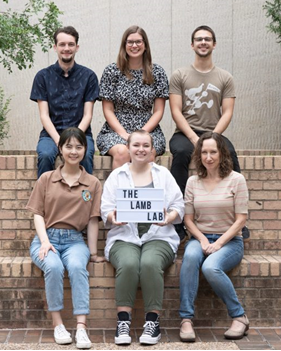Associate professor Katie Muenks has always been fascinated by how beliefs and perceptions can impact motivation and performance, both for students and teachers. Why do some students seem inherently motivated when others struggle to stay focused? How does one’s perception of themselves impact the way they interact with their education? How does a teacher’s mindset inform their instruction methods, and can these mindsets be changed? While Muenks’ research was originally focused on students, she’s been expanding her work to look at teachers and research mentors. Recently, Muenks received a National Institutes of Health (NIH) grant, which will allow her to partner with faculty from MD Anderson Cancer Center to explore how reducing psychological career threats can lead more biomedical trainees to stay in research-focused careers.
We spoke with Muenks about how she came to be interested in this field and some of the ways perception can shape academic achievement.

I’ve always been a motivated student. I loved school and felt excited to learn, but I started to notice that not all my peers were as excited to learn as I was. Things started getting a lot more difficult for me in college and grad school, and I became interested in how students maintain their motivation in these difficult contexts. I grew curious about students’ beliefs as a psychological mechanism for how they persist. I was fascinated by how we perceive our ability and our effort, as well as how students perceive their environment: their teachers, their peers, and the subjects they’re in.
One focus of my research has been the perspective of a teacher or instructor and how they can create an environment that is more conducive to motivational beliefs in students. Students will all come in with different backgrounds, personality traits and beliefs about themselves, but teachers have a lot of power to shape those through the messages they send to students. I’ve found that if a teacher is creating an environment that’s conducive to learning, where mistakes are okay and questions are encouraged, that can be really powerful.
A fixed mindset is the belief that your intelligence is static – you can’t change it, it’s innate. We see this a lot when people talk about being a “math person” or not. That’s a fixed mindset, the belief that some people are born good at math and some aren’t, and you can’t change it. A growth mindset is the opposite. It’s the belief that all your traits can change – intelligence can change with effective strategies and effort, and you can become a math person or learn anything you need to learn.
A lot of the work I’ve been doing recently is looking at how teachers communicate their mindset to students and how students perceive it. What I tend to find is that when students perceive their teachers to have a fixed mindset, it leads to a fear that they can’t truly be themselves or make mistakes. We call this a psychological vulnerability or a psychological threat. It’s a fear of making a mistake in front of a teacher because they’ll realize that you’re not naturally talented in this area. It can lead to lower motivation and an increased likelihood of leaving that field.
I’m really excited to be a part of this project. It’s an NIH-funded project in collaboration with researchers from MD Anderson Cancer Center, the University of Michigan and the University of North Carolina. We are interested in how to keep biomedical trainees – which we define as students in the biomedical sciences who are either doctoral students or postdoctoral scholars – engaged in a research career. There are a lot of students who start in the research field and end up leaving, and this is especially the case for underrepresented populations.
What I love about this study is that we’re doing these workshops with both trainees and mentors. We’re not just assuming we need to change the trainee – we’re looking at the broader culture in these labs and research groups. We are testing a series of interventions, both for trainees and their mentors, to try to mitigate some of the career threats they might experience. Specifically, we’re looking at imposter feelings, fixed mindsets and perceived discrimination, and we’re trying to understand if we can reduce those threats.
We do that through surveys, self-reports, interviews and focus groups. We try to get well-validated surveys on things like imposter phenomenon, growth mindset or self-efficacy, and then we measure what people believe about themselves. What I think is interesting about these methods is that we’re prioritizing the person’s perception, whether that’s objectively accurate or not. We’re more interested in how they perceive themselves than the reality of the situation because how they perceive it is going to impact their behavior and emotions.
One thing I’ve been looking at in my work is perceptions about other’s beliefs. When we looked at undergraduate STEM classrooms, we’d ask teachers what they did in the classroom and then ask the students what they perceived, and I’ve seen some cases where there was zero correlation between what students perceive is going on in the classroom and what the instructors intend. That was surprising and made me think about the fact that when instructors are trying to create a growth mindset in the classroom, that might not always translate to the students.
Another surprising finding: we collected some data on undergraduate engineering classes, and we found that students perceived their peers to have much more fixed mindsets than their professors, which made them reluctant to ask questions in front of their fellow students.
I would encourage teachers to communicate a growth mindset to their students. There are lots of ways they can do that, either through giving more specific feedback or advice to students who are struggling and imparting some strategies they can use to improve. This can also be done by giving students opportunities to revise and resubmit their work so they can learn from their mistakes.
When we see that classrooms are set up so there’s one midterm and one final and that’s it, it sends a message to students that they need to be naturally smart and pass these exams. But if you build in opportunities in these exams for practice or to get feedback, that can be motivationally supportive, especially for students who are struggling or wondering if they are good enough for that field.
For teachers, just being explicit about why you’re doing what you’re doing can be very helpful. One example is frequent quizzing. It can be an effective practice for learning, especially frequent, low-stakes quizzing, which can be helpful for memory retention. But students may not see quizzing that way. They might think it’s a punitive thing when really, it’s designed as an opportunity for growth.
I’m very interested in understanding how these processes I’m describing look in different contexts. A lot of the research I have done has been at research-focused or selective universities with predominately white student populations, but we know that most college students in the U.S. are going to community colleges or universities that aren’t R1 institutions, so I’ve been curious about how mindsets are being conveyed from teachers and peers in these different contexts.
I’m also interested in studying teachers’ beliefs about their role in the educational process. Do they feel their role is to be a gatekeeper for their field, to weed out people who aren’t going to be successful, or do they believe that their role is to reduce inequity?
Ultimately, I think the big question is: how do we help teachers who want to change their practices or engage in growth mindset practices? That’s part of what we’re trying to do with this NIH grant, to find more effective ways to help those teachers, especially at the college level. I don’t think there’s always the opportunity or incentive to push those boundaries, so how we translate this work to people across the U.S. and help faculty who are interested in engaging in some of these practices is a big-picture question I’m interested in.

